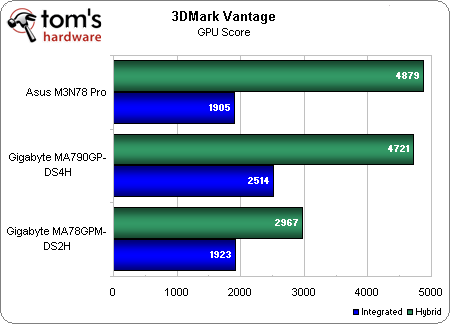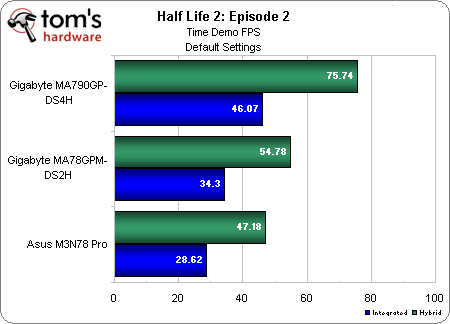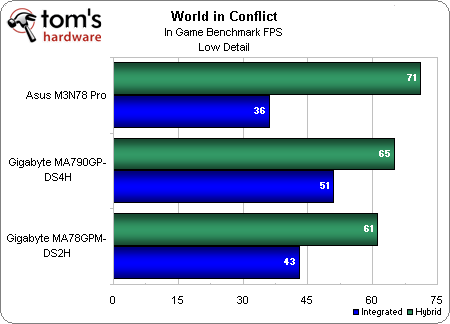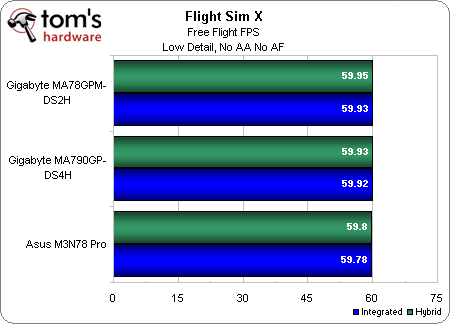AMD 790GX: RV610 For Enthusiasts?
Benchmarks: Gaming

As expected, the 790GX dominates 3D Mark Vantage using integrated graphics. The side-port memory-equipped 780G claims a second-place finish, but just barely.
The real upset occurs when you slide a GeForce 8500 GT into the Nvidia board, boosting performance from 1905 3DMarks to 4879. Of course, the race remains close, with AMD’s 790GX scoring 4721 3DMarks aided by Sapphire’s Radeon HD 3470 add-in card.

No surprise here. AMD dominates Half Life 2, delivering playable frame rates at 1024x768 using only integrated graphics. Under the influence of Hybrid CrossFireX, you’re set to either step things up to 1280x1024 or start turning on more of the game’s visual details at 1024x768. The 780G picks up a second-place finish. And although GeForce Boost serves the GeForce 8300 platform well, it’s not enough to catch Nvidia up in this one.

World in Conflict initially favors the 790GX’s 700 MHz GPU, followed by the 500 MHz 780G and then the GeForce 8300. But installing a GeForce 8500 GT catapults the 8300-based Asus board into the lead. Gigabyte’s 790GX follows, with the 780G motherboard just behind — both platforms armed with Sapphire Radeon HD 3470 cards.

Here’s an easy one. Even at 1024x768, all three of our integrated platforms offered enough graphics performance to keep Flight Simulator X pegged at its vsync cap.
Get Tom's Hardware's best news and in-depth reviews, straight to your inbox.
Current page: Benchmarks: Gaming
Prev Page Benchmarks: Synthetic, Continued Next Page Benchmarks: Media-
kitsilencer Great review, and it's good to see that AMD is at last able to target more enthusiast markets competitively.Reply -
cangelini kitsilencerGreat review, and it's good to see that AMD is at last able to target more enthusiast markets competitively.Reply
Thanks for the feedback Kit. -
waffle911 So... why does a page 15 and 16 of this article exist if there is no page 15 or 16 to the article?Reply
Take a closer look. What happened? -
YYD PCMark seems Intel biased, please read this:Reply
http://arstechnica.com/reviews/hardware/atom-nano-review.ars/6
Please change this benchmark suite or check if PcMark Vantage is unbiased. -
cangelini waffle911So... why does a page 15 and 16 of this article exist if there is no page 15 or 16 to the article?Take a closer look. What happened?Reply
That was strange. Should be fixed now.
-
cangelini YYDPCMark seems Intel biased, please read this:http://arstechnica.com/reviews/har view.ars/6Please change this benchmark suite or check if PcMark Vantage is unbiased.Reply
Fortunately, with no Intel platforms tested, this should be a non-issue for the current situation ;-) In the future, you'll be seeing SYSmark, though. -
Seems past page 8 or something the links are corrupt.. can't fully read this article and getting error 404 - page not found.Reply
-
cangelini lacrits.. and now the article seems to be removed even from the main page!?!?!Reply
Alright, mystery solved. It's back up, sans the blank page. Thanks for pointing that out lacrits!
